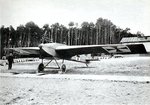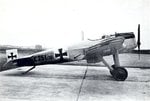Hi Juha,
>I'm a layman on Meredith Effect, but I'd not be surprised if Germans also with all their theoretical knowledge knew the effect.
Good call. It would in fact more properly be called the "Junkers effect" as Junkers patented the diffusor-radiator-jet combation as "Düsenkühler" ('jet cooler') in DRP 299799 on 17 January, 1915. (Von Gersdorff et al., "Deutsche Flugmotoren und Strahltriebwerke, p. 196.)
The principle obviously was well-known in the English-speaking part of the aviation industry as well. "Fundamentals of Fighter Design" by Ray Whitford notes (p. 61): "In 1926 it was realized that airflow through the radiators on liquid-cooled engines could, if properly ducted, eliminate the cooling drag and even produce a little thrust at speeds above 260 kts (483 km/h)."
Flugzeug Classic in one of their early issues quoted from a speech given by Willy Messerschmitt at some congress in the late 1930s in which he praised the Junkers jet cooler as the most important single contribution to high speed flight as it cut down the otherwise prohibitive cooling drag, pointing out that the most advantageous way to incorporate the concept in a high-speed aircraft was in the form of wing radiators.
To me, it looks as if thrust recovery from radiator cooling was fairly well-known in the international aviation industry of the 1930s, and as if the Mustang differed from similar designs only through the particularly efficient way this well-known principle was implemented.
Regards,
Henning (HoHun)
>I'm a layman on Meredith Effect, but I'd not be surprised if Germans also with all their theoretical knowledge knew the effect.
Good call. It would in fact more properly be called the "Junkers effect" as Junkers patented the diffusor-radiator-jet combation as "Düsenkühler" ('jet cooler') in DRP 299799 on 17 January, 1915. (Von Gersdorff et al., "Deutsche Flugmotoren und Strahltriebwerke, p. 196.)
The principle obviously was well-known in the English-speaking part of the aviation industry as well. "Fundamentals of Fighter Design" by Ray Whitford notes (p. 61): "In 1926 it was realized that airflow through the radiators on liquid-cooled engines could, if properly ducted, eliminate the cooling drag and even produce a little thrust at speeds above 260 kts (483 km/h)."
Flugzeug Classic in one of their early issues quoted from a speech given by Willy Messerschmitt at some congress in the late 1930s in which he praised the Junkers jet cooler as the most important single contribution to high speed flight as it cut down the otherwise prohibitive cooling drag, pointing out that the most advantageous way to incorporate the concept in a high-speed aircraft was in the form of wing radiators.
To me, it looks as if thrust recovery from radiator cooling was fairly well-known in the international aviation industry of the 1930s, and as if the Mustang differed from similar designs only through the particularly efficient way this well-known principle was implemented.
Regards,
Henning (HoHun)


